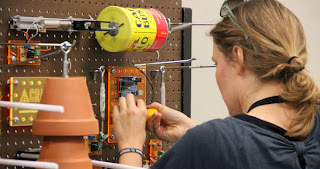 |
| from remakelearning.org |
Constructionism is just what it sounds like…making something
and learning through the making. While I was still teaching there were sometimes
projects that were incorporated into the curriculum, and then the projects were
shared. We made topographical maps from salt clay to learn about land forms, we
wrote books based on field trip experiences and we cooked. All of these ended
with artifacts that we shared with parents, other classes and each other.
However, most of the time the projects had very clear guidelines and
requirements which constricted the flow of learning and guided it in a very
specific direction with very specific goals in mind. This week’s readings
showed me that to exploit the power of making, teachers must be able to stand back
more, and allow students more freedom to explore, reflect, revise and share.
The guidance has to be subtle; more like making sure the baby does not fall into
the lake than making sure the baby stays on the concrete path. There is so much
more to be learned by touching the trees, walking on the grass, picking up the
stones and crunching the leaves than by walking carefully in the middle of the
sidewalk. As a teacher, I tended to be sure we got where we were going, even if I
had to grab the learners’ hands and drag them quickly with me to the goal.
Switching to a more learner-centered classroom practice would be hard, but I think, worth the effort. Allowing students more control over how and what and when they learn would give them the opportunity to develop skills they cannot when the are being led. Walking with a three year old anywhere can be frustrating if the point is to get there fast. Walking with a three year old and noticing what they discover, and listening to the questions they ask can be not only enlightening, but delightful. Giving students the tools to create their own learning can be delightful and enlightening as well, as long as the teacher can provide a clear goal and guidance along the way.(Han & Bhattacharya, 2001) Using technology as a part of the learner-centered classroom, giving students tools to create their learning makes sense for the world our students are living in. Technology opens doors for students, giving them tools that expand not only their access to information, but also breaking down the walls of the classroom and inviting the whole world in as part of the learning space.
 |
| from spotlight.macfound.org |
Giving students a problem to solve or a project to create, can certainly fall under the umbrella of constructionism. In order to solve the problem, one that is important to the students and is an authentic task, they have to do all sorts of learning. They need to reflect on the problem from their experience and previous learning and with guidance move from problem to solution. (Laureate Education, Inc, 2011) Along the way they have the opportunity to work together, ask questions, find answers, reflect on their paths, and revise their thoughts. They will undoubtedly have conflicting ideas about where to go and how to get there, but can arrive at an answer through discussion and collaboration and with teacher guidance.
In this week's readings, students were given spreadsheets with data and asked to produce hypotheses about what the data might mean, then asked to use the data to prove or disprove their hypotheses. (Pitler, Hubbell & Kuhn, 2012) In order to come up with logical and supportable hypotheses, they have to think deeply and critically about the data. This undoubtedly created excellent opportunities for learning and based on Papert's statement that "Learners don't get ideas; they create ideas." this activity can also fall under the contructionist umbrella. (Han & Bhattacharya, 2001). These students are not creating an artifact, but though the problem they are asked to solve may be a limited one, they are coming up with a solution. The authors of our text also suggest using software that supports brainstorming and using graphic organizers to allow students to put their thoughts into a scaffold to help them come up with hypotheses. This is needed because looking at data and coming up with hypotheses is a high level cognitive task. (Pitler, Hubbell & Kuhn). These technology tools which support student learning and expand their ability to hold and process information are constructionist tools in this case. Students are creating webs of information to help them organize their thoughts so that they can find answers to their questions.
To construct learning, students need tools, and technology provides tools of all sorts that are useful for many skill levels. The tools are many and varied and can be tailored to particular needs. When students have access to many technology tools, they can more easily build from their experience and create ideas that will lead them on to new learning.
References
Han, S., and Bhattacharya, K. (2001). Constructionism,
Learning by Design, and Project Based Learning. In M. Orey (Ed.), Emerging
perspectives on learning, teaching, and technology. Retrieved September 20, 2013, from http://projects.coe.uga.edu/epltt/
Laureate
Education, Inc. (Producer). (2011). Program seven: Constructionist and
constructivist learning theories [Video webcast]. Bridging
learning theory, instruction and technology. Retrieved from http://laureate.ecollege.com/ec/crs/default.learn?CourseID=5700267&CPURL=laureate.ecollege.com&Survey=1&47=2594577&ClientNodeID=984650&coursenav=0&bhcp=1
Pitler, H., Hubbell, E. R., & Kuhn, M. (2012). Using technology with classroom instruction that works (2nd ed.). Alexandria, VA: ASCD.


